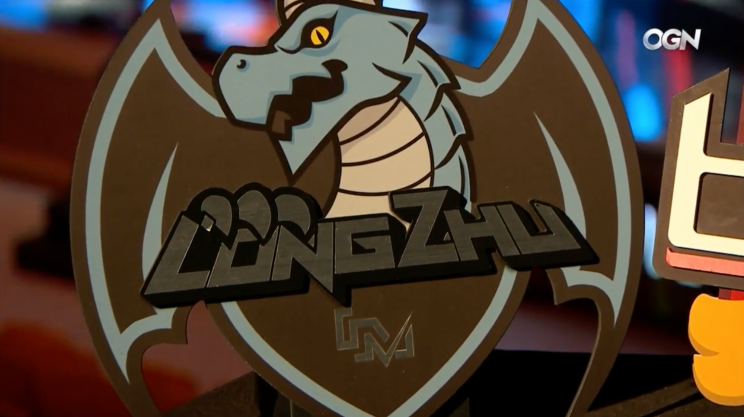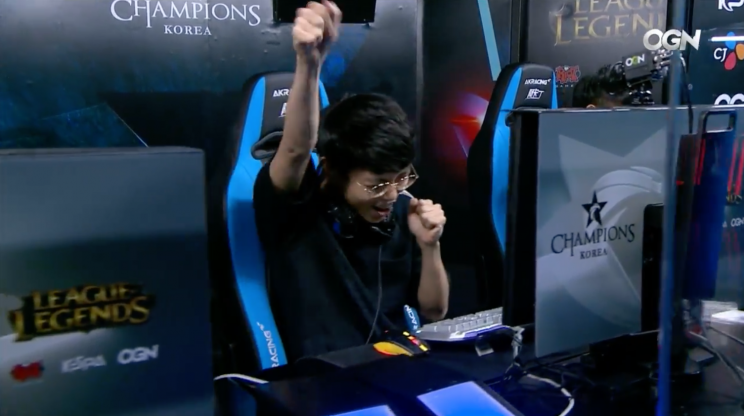The Longzhu Gaming case studies of Crash and Cuzz

Days before their first match of 2017 League of Legends Champions Korea Summer, Inven Global released an investigative report on Longzhu Gaming. Former Longzhu players — notably AD carry Kim “Emperor” Jin-hyun and top laner Koo “Expession” Bon-taek — and staff that included current coach Kang “Hirai” Dong-hoon came forward, expressing their disappointment and frustration with Longzhu for unpaid salaries and delayed signings of contracts.
Since their restructuring from the beleaguered Incredible Miracle to supposed superteam Longzhu Gaming, Longzhu has performed below expectations. They spent the majority of 2016 waffling between lineups, finishing seventh in spring and eighth in summer — just out of relegation but far away from playoff contention.
Longzhu didn’t fare any better in the 2017 LCK Spring season, even with the addition of the former ROX Tigers bottom lane: Kim “PraY” Jong-in and Kang “GorillA” Beom-hyeon. Again, they finished in seventh. The Inven Global report provided much-needed context into Longzhu’s situation. The administrative issues weren’t the only reason the team had struggled for a year and a half — even the slightest glance at their form on the Rift reveals poor synergy, ill-timed Teleports, mismatched lane assignments, among a myriad of other issues — but they were certainly a factor.
As the saying goes, time heals all wounds. Although these particular wounds have hardly been healed, and Longzhu’s Facebook apology leaves a lot to be desired — in the case of Longzhu Gaming, it didn’t take much time for someone else on the team to catch the LCK audience’s attention: rookie jungler Moon “Cuzz” Woo-chan.

At least some of the etymology of hype comes from hyperbole. Getting hyped or excited about an up-and-coming player is only natural, especially if the team they’ve joined has struggled in the past. Many fans were hyped for Longzhu’s original 2016 debut, only to be disappointed by the team’s actual performance.
In addition to healing all wounds, time allows for inspection, introspection, and context, the latter of which is often only available after the fact. As time has passed, the so-called superteam of 2016 has been more thoroughly examined and — even with the latest news of Longzhu’s mismanagement — was found lacking. Now, it’s up to the new roster built around Cuzz, mid laner Gwak “Bdd” Bo-seong, former Prime Optimus and Newbee/Qiao Gu top laner Kim “Khan” Dong-ha, and their veteran bottom lane of PraY and GorillA to pick up the pieces.
A solo queue phenom, Cuzz joined Longzhu last year, shortly after his 17th birthday. He spent all of the 2017 spring season on the bench while Longzhu’s once-lauded jungler Lee “Crash” Dong-woo occupied the starting spot. When Crash left Longzhu for Vici Gaming in the mid-year offseason, the Cuzz hype began.
Before Cuzz, there was Longzhu Gaming’s Crash, formerly ShowTime and T.Bear Gaming’s “goeat.” Despite middling to poor results for both teams, goeat was a standout in China’s LoL Secondary Pro League with visible talent.
Talent does not always translate into victory and goeat joined Longzhu Gaming under the radar of most LoL Champions Korea fans. Longzhu had already signed former Jin Air Green Wings jungler Lee “Chaser” Sang-hyun the day prior, along with the majority of their ten-man roster. Outside of the LSPL faithful few knew of Crash, despite his solo queue highlights.
This changed on February 3, 2016, after Longzhu’s series against CJ Entus. It wasn’t Crash’s LCK debut (that came against the Afreeca Freecs the previous week), but it was the outing that most remember as his first, due to his impressive starts on Nidalee and Graves despite a 2-1 series loss.
Crash’s adversary in these matches was Park “Bubbling” Jun-hyeong, the once-hyped jungler of Anarchy and Winners, before they later became the Afreeca Freecs and Ever8 Winners. By the time he faced Crash on CJ Entus, the Bubbling praise had long since passed. Bubbling did not work out, and has yet to find a team since his release on November 30, 2016.
Jungle in particular is a difficult position to make the transition from a solo queue success to remarkable professional player. Even with the strongest solo queue ladder in the world, Korean players concede that jungling in solo queue is completely different from jungling on a team. Jungle knowledge frequently comes from experience, which often requires time and a strong support staff.
Although he only played 11 total games for Longzhu during the 2016 LCK Spring, Crash’s statistics over that time period speak volumes. Alongside his remarkable CS differential at 10 minutes (7) and gold differential at 10 minutes (324), the best of all LCK junglers that season, Crash had the largest percentage of his team’s deaths (29 percent) and the fourth-lowest KDA (2.7). For every step forward, Crash seemed to take two steps back.
Despite his inconsistency, Crash’s shared time with Chaser became a point of contention for the 2016 Longzhu lineup, especially when the team continued to mix and match their starting players, seemingly with little to no thought. Following Chaser’s departure in 2017, great things were expected of Crash. Those Nidalee and Graves games against Bubbling and CJ Entus stuck in spectators’ minds.
Crash never delivered on those unspoken promises made in that CJ Entus series. Whether it was due to a lack of coaching, learning retention, bad communication, or poor environment, Crash had a difficult 2017 LCK Spring split. He often did his own thing, separate from his teammates, ending up with the second-lowest kill participation (64.7 percent) of any jungler that split. This statistic alone isn’t good or bad — SK Telecom T1’s Han “Peanut” Wang-ho had the third-worst at 65 percent — but tells a lot about how Longzhu operated as a team.
Had Crash retained his remarkable farming and experience differentials of his LCK debut season, he would have been a mid-game monster after power-farming through the early game. Unfortunately, Crash’s early game efficiency and performance also suffered.
His statistics, including a -44 experience differential at 10 minutes, a -1.2 CS differential at 10 minutes, and 5.2 CS per minute were middling at best. In spite of all this, Crash received the third-highest percentage of his team’s farm past 15 minutes (16.4 percent) only to be a non-factor in the majority of Longzhu’s 2017 spring series.
What makes a jungler good is a hotly-debated topic among professional players, coaches, analysts, and fans. It’s easy to be visually dazzled by a Lee Sin kick, smart Elise cocoon, or even efficient farming to shut down an opponent. However, like evaluating the success or failure of a player or a team, context and time is required. Early repetitive ganks aren’t a measure of success, although they appear meaningful in the moment. Power-farming, even with efficient pathing, means nothing if a jungler can’t coordinate with their team to make something out of that experience or farm advantage.
The Korean League of Legends scene is littered with highly-ranked solo queue junglers that didn’t pan out on professional teams for one reason or another. Other times, like the case of Samsung’s Kang “Haru” Min-seung, development takes time and perhaps a change of scenery.
A cursory look at Cuzz’s jungle pathing, what little of it is available from two series in Week 1, reveals nothing noteworthy. He looks like a solo queue jungler who is transitioning into a professional role with solid, not spectacular, map movement. Crash had a stronger sense of invades and was more efficient in his first few LCK games, likely due to his experience in the LSPL.
What Cuzz does have is seemingly strong synergy with mid laner Gwak “Bdd” Bo-seong, a similar product of hype before his own debut last year.

Bdd’s solo queue exploits and scrims with western teams that were bootcamping in Korea prior to the 2015 League of Legends World Championship left a strong impression. At the time, he was too young to compete for CJ Entus in LCK, but scrimmed with the team. When it was finally time for him to make his highly-anticipated start, Bdd looked disconnected from his teammates. Despite better mechanics than mid laner Kim “Sky” Ha-neul, Bdd was often subbed out in favor of Sky, who appeared to have stronger communication with the team. Longzhu acquired him in the 2016-17 offseason, but Bdd sat on the bench for the entire split while Song “Fly” Yong-jun started.
Now with Cuzz, Bdd is at the forefront of this new Longzhu lineup, nearly a year after his debut. Sometimes, these things take time and experience.
It’s not difficult to see why fans and analysts salivate over the next solo queue prodigy. Lee “Faker” Sang-hyeok is now the best player in the world, and made a name for himself as GoJeonPa on the ranked ladder. Peanut was similarly lauded prior to his debut and, after a slight diversion on Najin, found the ROX Tigers and later SK Telecom T1. However, solo queue is a measure of raw mechanical skill, only one of a multitude of things that make up a professional League of Legends player. Here’s to hoping that Longzhu can make the most out of Cuzz’s impressive mechanics and give him a strong working environment to succeed.
Statistics courtesy of Oracle’s Elixir.
Emily Rand’s love of the 2013 KT Rolster Bullets will never die. You can follow her on Twitter.


